Analysis of Spatial Structure in the Kashgar Metropolitan Area, China
Abstract
:1. Introduction
2. Literature Review
3. Conceptual Framework
4. Material and Methods
4.1. Study Area
4.2. Data Sources
4.3. Research Methods
4.3.1. Zipf’s Law (The Rank-Size Rule)
4.3.2. Central Place Theory
4.3.3. Gravity Model
Calculation of Economic Distance
Gravity Model
5. Results
5.1. The City Size Distribution Evolution Characteristics
5.2. Spatial Structure Characteristics of the KMA
6. Discussion
6.1. The City Size Distribution Characteristics
6.2. Policy Implications
6.3. Limitations and Future Research Directions
7. Conclusions
- (1)
- It was found that the Pareto index of the KMA from 2000 to 2018 was greater than 1, indicating that large cities have a high primacy of development, while small and medium-sized cities are underdeveloped. The change characteristics of the grade scale fitting curve show that the scale of high-primacy cities has decreased, but this is not obvious. This is also confirmed by the economic and urban population size of cities in the KMA. Therefore, at present, the KMA is a concentrated monocentric-pattern metropolitan area, with Kashgar City as its core city.
- (2)
- The urban built-up area of Kashgar City is expanding to the east and south, where it has broken through the administrative boundary and become integrated with the urban built-up area of Shule County. With the help of the gravity model, the spatial structure characteristics of the KMA have been further clarified. Shule County, Shufu County, and Artux City are the core circle; Akto County, Yengisar County, Shache County, and Jiashi County are the middle circle; and Yecheng County, Bachu County, Wuqia County, Makit County, Yopurga County, Zepu County, Tumxuk City, Taxkorgan Tajik Autonomous County, and Akqi County have a low economic correlation with the core city and form the outer circle.
- (3)
- Tumxuk City, Bachu County, Yecheng County, Shache County, and other counties are far from the core city and cannot be connected with Kashgar, but they are closely related to the surrounding cities, forming the Bachu–Tumxuk Urban Group and the Shache–Zepu–Yecheng Urban Group.
Author Contributions
Funding
Institutional Review Board Statement
Informed Consent Statement
Data Availability Statement
Acknowledgments
Conflicts of Interest
References
- Xu, J.; Yeh, A.G. Governance and Planning of Mega-City Regions: An International Comparative Perspective. In Devon: Routledge Studies in Human Geography; Routledge: Abingdon-on-Thames, UK, 2011. [Google Scholar]
- Scott, A.J. Global City-Regions: Trends, Theory, Policy; OUP: Oxford, UK, 2001. [Google Scholar]
- Ingram, G.K. Patterns of metropolitan development: What have we learned? Urban Stud. 1998, 35, 1019–1035. [Google Scholar] [CrossRef] [Green Version]
- Lin, G.C.S. Metropolitan development in a transitional socialist economy: Spatial restructuring in the Pearl River Delta, China. Urban Stud. 2001, 38, 383–406. [Google Scholar] [CrossRef]
- Ye, L. State-led metropolitan governance in China: Making integrated city regions. Cities 2014, 41, 200–208. [Google Scholar] [CrossRef]
- He, S.; Fang, C.; Zhang, W. A geospatial analysis of multi-scalar regional inequality in China and in metropolitan regions. Appl. Geogr. 2017, 88, 199–212. [Google Scholar] [CrossRef]
- OECD; European Commision. A New Perspective on Urbanization; OECD: Paris, France, 2020. [Google Scholar]
- Cherlet, M.; Hutchinson, C.; Reynolds, J.; Hill, J.; Sommer, S.; Von Maltitz, G. World Atlas of Desertification: Rethinking Land Degradation and Sustainable Land Management; Publications Office of the European Union: Luxembourg, 2018. [Google Scholar]
- IUCN. Drylands and Land Degradation. Available online: https://www.iucn.org/resources/issues-briefs/drylands-and-land-degradation (accessed on 5 March 2020).
- Mortimore, M.; Anderson, S.; Cotula, L.; Davies, J.; Faccer, K.; Hesse, C.; Morton, J.; Nyangena, W.; Skinner, J.; Wolfangel, C. Dryland Opportunities: A New Paradigm for People, Ecosystems and Development; International Union for Conservation of Nature: Gland, Switzerland, 2009. [Google Scholar]
- Reynolds, J.F.; Smith, D.M.; Lambin, E.F.; Turner, B.L.; Mortimore, M.; Batterbury, S.P.; Downing, T.E.; Dowlatabadi, H.; Fernandez, R.J.; Herrick, J.E.; et al. Global desertification: Building a science for dryland development. Science 2007, 316, 847–851. [Google Scholar] [CrossRef] [PubMed] [Green Version]
- Middleton, N.J.; Sternberg, T. Climate hazards in drylands: A review. Earth Sci. Rev. 2013, 126, 48–57. [Google Scholar] [CrossRef]
- Armah, F.A.; Odoi, J.O.; Yengoh, G.T.; Obiri, S.; Yawson, D.O.; Afrifa, E.K.A. Food security and climate change in drought-sensitive savanna zones of Ghana. Mitig. Adapt. Strateg. Glob. Change 2011, 16, 291–306. [Google Scholar] [CrossRef]
- Li, J.; Lei, J.; Li, S.; Yang, Z.; Tong, Y.; Zhang, S.; Duan, Z. Spatiotemporal analysis of the relationship between urbanization and the eco-environment in the Kashgar metropolitan area, China. Ecol. Indic. 2022, 135, 108524. [Google Scholar] [CrossRef]
- Xie, Y.; Ward, R.; Fang, C.; Qiao, B. The urban system in West China: A case study along the mid-section of the ancient Silk Road–He-Xi Corridor. Cities 2007, 24, 60–73. [Google Scholar] [CrossRef]
- Cai, Z.; Liu, Q.; Cao, S. Real estate supports rapid development of China’s urbanization. Land Use Policy 2020, 95, 104582. [Google Scholar] [CrossRef]
- Lin, J.; Lei, J.; Yang, Z.; Li, J. Differentiation of Rural Development Driven by Natural Environment and Urbanization: A Case Study of Kashgar Region, Northwest China. Sustainability 2019, 11, 6859. [Google Scholar] [CrossRef] [Green Version]
- Mamat, A.; Halik, Ü.; Rouzi, A. Variations of Ecosystem Service Value in Response to Land-Use Change in the Kashgar Region, Northwest China. Sustainability 2018, 10, 200. [Google Scholar] [CrossRef] [Green Version]
- Fang, C.L. China’s Urban Agglomeration and Metropolitan Area Construction under the New Development Pattern. Econ. Geogr. 2021, 41, 1–7. [Google Scholar]
- Gutierrez, J.; García-Palomares, J.C. New spatial patterns of mobility within the metropolitan area of Madrid: Towards more complex and dispersed flow networks. J. Transp. Geogr. 2007, 15, 18–30. [Google Scholar] [CrossRef]
- Lin, G.; Jiang, D.; Fu, J.; Zhao, Y. A Review on the Overall Optimization of Production–Living–Ecological Space: Theoretical Basis and Conceptual Framework. Land 2022, 11, 345. [Google Scholar] [CrossRef]
- Castañer, M. La ciudad real en Cataluña. Las áreas de cohesión. Ciudad. Y Territ. Estud. Territ. 1994, 99, 101–115. [Google Scholar]
- Fragkias, M.; Seto, K.C. Evolving rank-size distributions of intra-metropolitan urban clusters in South China. Comput. Environ. Urban Syst. 2009, 33, 189–199. [Google Scholar] [CrossRef]
- Mu, L.; Wang, X. Population landscape: A geometric approach to studying spatial patterns of the US urban hierarchy. Int. J. Geogr. Inf. Sci. 2006, 20, 649–667. [Google Scholar] [CrossRef]
- McGee, T.G. The emergence of Desa-kota regions in Asia: Expanding a hypothesis. In The Extended Metropolis: Settlement Transition in Asia; University of Hawaii Press: Mānoa valley, HI, USA, 1991. [Google Scholar]
- Gottmann, J. Megalopolis or the urbanization of the northeastern seaboard. Econ. Geogr. 1957, 33, 189–200. [Google Scholar] [CrossRef]
- Wei, W.; Zhao, G. Research on patterns of Japanese Metropolitans circles: A literature review. Contemp. Econ. Jpn. 2005, 140, 40–45. [Google Scholar]
- Martin, D. Automatic neighbourhood identification from population surfaces. Environ. Urban Syst. 1998, 22, 107–120. [Google Scholar] [CrossRef]
- Zhuo, Y.; Shi, Y. Toward establishing the concept of physical urban area in China. Acta Geogr. Sin. 1995, 50, 289–301. (In Chinese) [Google Scholar]
- Ning, Y. Definition of Chinese Metropolitan Areas and Large Urban Agglomerations: Role of Large Urban Agglomerations in Regional Development. Sci. Geogr. Sin. 2011, 31, 289–301. (In Chinese) [Google Scholar]
- Gu, C. A preliminary study on the division of urban economic regions in China. Acta Geogr. Sin. 1991, 46, 129–141. (In Chinese) [Google Scholar]
- Zhuo, Y. Urban Geography; Beijing Commercial Press: Beijing, China, 1995. (In Chinese) [Google Scholar]
- Wang, Z.; Li, J.; Liang, L. Identifying the scope of the Lhasa Metropolitan Area based on a spatial field energy model. J. Geogr. Sci. 2021, 31, 245–264. [Google Scholar] [CrossRef]
- Luo, S.; Johnston, A.; Chen, D. Approach to delimiting metropolitan regions’ boundary and grading urban hierarchy within a metropolitan region—A case study of Shanghai metropolitan region. Chin. Geogr. Sci. 2008, 18, 197–205. [Google Scholar] [CrossRef]
- Yue, W.; Chen, Y.; Thy, P.T.M.; Fan, P.; Liu, Y.; Zhang, W. Identifying urban vitality in metropolitan areas of developing countries from a comparative perspective: Ho Chi Minh City versus Shanghai. Sustain. Cities Soc. 2021, 65, 102609. [Google Scholar] [CrossRef]
- Dadashpoor, H.; Malekzadeh, N. Evolving spatial structure of metropolitan areas at a global scale: A context-sensitive review. GeoJournal 2021, 86, 1–28. [Google Scholar] [CrossRef]
- Baum-Snow, N. Changes in Transportation Infrastructure and Commuting Patterns in U.S. Metropolitan Areas, 1960–2000. Am. Econ. Rev. 2010, 100, 378–382. [Google Scholar] [CrossRef] [Green Version]
- McMillen, D.P. Employment Densities, Spatial Autocorrelation, and Subcenters in Large Metropolitan Areas. J. Reg. Sci. 2004, 44, 225–244. [Google Scholar] [CrossRef]
- Saghapour, T.; Moridpour, S.; Thompson, R.G. Public transport accessibility in metropolitan areas: A new approach incorporating population density. J. Transp. Geogr. 2016, 54, 273–285. [Google Scholar] [CrossRef]
- Mazzocchi, C.; Sali, G.; Corsi, S. Land use conversion in metropolitan areas and the permanence of agriculture: Sensitivity Index of Agricultural Land (SIAL), a tool for territorial analysis. Land Use Policy 2013, 35, 155–162. [Google Scholar] [CrossRef]
- Anas, A.; Arnott, R.; Small, K.A. Urban Spatial Structure. J. Econ. Lit. 1998, 36, 1426–1464. [Google Scholar]
- Lee, B. “Edge” or “Edgeless” Cities? Urban Spatial Structure in U.S. Metropolitan Areas, 1980 to 2000*. J. Reg. Sci. 2007, 47, 479–515. [Google Scholar] [CrossRef]
- Li, Y.; Derudder, B. Dynamics in the polycentric development of Chinese cities, 2001–2016. Urban Geogr. 2020, 43, 272–292. [Google Scholar] [CrossRef]
- Li, Y.; Liu, X. How did urban polycentricity and dispersion affect economic productivity? A case study of 306 Chinese cities. Landsc. Urban Plann. 2018, 173, 51–59. [Google Scholar] [CrossRef]
- Wei, W.; Zhang, X.; Liu, C.; Zhou, J.; Xie, B.; Li, C. Spatial Interaction of Urban-Rural System and Influence Pattern in the Arid Inland River Basin—A Case Study in Shiyang River Basin in Northwest China. Pol. J. Environ. Stud. 2021, 30, 3307–3316. [Google Scholar] [CrossRef]
- Paker, Y.; Yom-Tov, Y.; Alon-Mozes, T.; Barnea, A. The effect of plant richness and urban garden structure on bird species richness, diversity and community structure. Landsc. Urban Plann. 2014, 122, 186–195. [Google Scholar] [CrossRef]
- Tannier, C.; Thomas, I. Defining and characterizing urban boundaries: A fractal analysis of theoretical cities and Belgian cities. Comput. Environ. Urban Syst. 2013, 41, 234–248. [Google Scholar] [CrossRef]
- Christiaensen, L.; Todo, Y. Poverty Reduction during the Rural–Urban Transformation–The Role of the Missing Middle. World Devel. 2014, 63, 43–58. [Google Scholar] [CrossRef]
- Zhang, J.; Zou, J.; Wu, Q.; Chen, X. On the spatial organization of the metropolitan area. City Plan. Rev. 2001, 25, 19–23. [Google Scholar]
- Hsu, W.T. Central Place Theory and City Size Distribution. Econ. J. 2012, 122, 903–932. [Google Scholar] [CrossRef]
- Petrakos, G.; Brada, J.C. Metropolitan Concentration in Developing Countries. Kyklos 1989, 42, 557–578. [Google Scholar] [CrossRef] [PubMed]
- Hu, C.; Liu, W.; Jia, Y.; Jin, Y. Characterization of Territorial Spatial Agglomeration Based on POI Data: A Case Study of Ningbo City, China. Sustainability 2019, 11, 5083. [Google Scholar] [CrossRef] [Green Version]
- Chavhan, S.; Venkataram, P. Prediction based traffic management in a metropolitan area. J. Traffic Transp. Eng. Engl. Ed. 2020, 7, 447–466. [Google Scholar] [CrossRef]
- Nagy, J.A.; Benedek, J.; Ivan, K. Measuring Sustainable Development Goals at a Local Level: A Case of a Metropolitan Area in Romania. Sustainability 2018, 10, 3962. [Google Scholar] [CrossRef] [Green Version]
- Zhang, Q.; Su, S. Determinants of urban expansion and their relative importance: A comparative analysis of 30 major metropolitans in China. Habitat Int. 2016, 58, 89–107. [Google Scholar] [CrossRef]
- Molina, L.T.; Velasco, E.; Retama, A.; Zavala, M. Experience from Integrated Air Quality Management in the Mexico City Metropolitan Area and Singapore. Atmosphere 2019, 10, 512. [Google Scholar] [CrossRef] [Green Version]
- Dadashpoor, H.; Azizi, P.; Moghadasi, M. Land use change, urbanization, and change in landscape pattern in a metropolitan area. Sci. Total Environ. 2019, 655, 707–719. [Google Scholar] [CrossRef]
- Mumtaz, F.; Tao, Y.; de Leeuw, G.; Zhao, L.; Fan, C.; Elnashar, A.; Naeem, S. Modeling Spatio-temporal Land Transformation and Its Associated Impacts on land Surface Temperature (LST). Remote Sens. 2020, 12, 2987. [Google Scholar] [CrossRef]
- Xia, C.; Zhang, A.; Wang, H.; Zhang, B.; Zhang, Y. Bidirectional urban flows in rapidly urbanizing metropolitan areas and their macro and micro impacts on urban growth: A case study of the Yangtze River middle reaches megalopolis, China. Land Use Policy 2019, 82, 158–168. [Google Scholar] [CrossRef]
- Zhang, Q.; Li, J.; Singh, V.P.; Bai, Y. SPI-based evaluation of drought events in Xinjiang, China. Nat. Hazards 2012, 64, 481–492. [Google Scholar] [CrossRef]
- Auerbach, F. Das gesetz der belvolkerungskoncertration. Petermanns Geogr. Mitt. 1913, 59, 74–76. Available online: https://zs.thulb.uni-jena.de/receive/jportal_jpvolume_00158800 (accessed on 5 March 2020).
- Gabaix, X.; Ibragimov, R. Rank−1/2: A Simple Way to Improve the OLS Estimation of Tail Exponents. J. Bus. Econ. Stat. 2011, 29, 24–39. [Google Scholar] [CrossRef] [Green Version]
- Zipf, G.K. The P1 P2/D Hypothesis: On the Intercity Movement of Persons. Am. Sociol. Rev. 1946, 11, 677–686. [Google Scholar] [CrossRef]
- Zipf, G.K. Human Behaviour and The Principle of Least Effort; Addison-Wesley: Boston, MA, USA, 1949. [Google Scholar]
- Fan, X.; Pang, P. Spatial range recognition of the Xian metropolitan area based on multi source data. J. Xi’an Univ. Arch. Tech. Natl. Sci. Ed. 2021, 53, 254–264. (In Chinese) [Google Scholar]
- Zhou, X.; Tang, X. Wuhan Metropolitan Area Limits Based on Gravity Model and Its Optimization of Industrial Structure. Geomat. Spat. Inf. Technol. 2016, 39, 73–81. (In Chinese) [Google Scholar]
- Jung, W.-S.; Wang, F.; Stanley, H.E. Gravity model in the Korean highway. EPL Europhys. Lett. 2008, 81, 48005. [Google Scholar] [CrossRef] [Green Version]
- Berry, B.J. City Size Distributions and Economic Development. Econ. Dev. Cult. Change 1961, 9, 573–588. [Google Scholar] [CrossRef]
- Mori, T.; Smith Tony, E.; Hsu, W.-T. Common power laws for cities and spatial fractal structures. Proc. Natl. Acad. Sci. USA 2020, 117, 6469–6475. [Google Scholar] [CrossRef] [Green Version]
- Song, Y.X.; Zheng, H.B. Study on the optimum pattern of daqing urban spatial structure. Chin. Geogr. Sci. 2002, 12, 206–211. [Google Scholar] [CrossRef]
- Li, S.M.; Shum, Y.M. Impacts of the National Trunk Highway System on accessibility in China. J. Transp. Geogr. 2001, 9, 39–48. [Google Scholar] [CrossRef]
- Wei, W.U.; Cao, Y.H.; Cao, W.D.; Liang, S.B. Spatial Pattern of Regional Comprehensive Transportation Cost—The Case of Jiangsu Province. Sci. Geogr. Sin. 2009, 29, 485–492. [Google Scholar]
- Wu, R.; Wang, J.; Zhang, D.; Wang, S. Identifying different types of urban land use dynamics using Point-of-interest (POI) and Random Forest algorithm: The case of Huizhou, China. Cities 2021, 114, 103202. [Google Scholar] [CrossRef]
- Hu, T.; Yang, J.; Li, X.; Gong, P. Mapping Urban Land Use by Using Landsat Images and Open Social Data. Remote Sens. 2016, 8, 151. [Google Scholar] [CrossRef]
- Zhang, H.; Li, X.; Liu, X.; Chen, Y.; Ou, J.; Niu, N.; Jin, Y.; Shi, H. Will the development of a high-speed railway have impacts on land use patterns in China? Ann. Am. Assoc. Geogr. 2019, 109, 979–1005. [Google Scholar] [CrossRef]
- Yang, Z.; Bai, J.; Zhang, W. Mapping and assessment of wetland conditions by using remote sensing images and POI data. Ecol. Indic. 2021, 127, 107485. [Google Scholar] [CrossRef]
- Zhao, W.; Li, Q.; Li, B. Extracting hierarchical landmarks from urban POI data. J. Remote Sens. 2011, 15, 973–988. [Google Scholar]
- Sun, C.L.; Zhang, X.L.; Jin, N.; Du, H.R. Spatial difference features and organization optimization of cities and towns in Tarim River Basin. J. Arid. Land 2010, 2, 33–42. [Google Scholar]
- Zhang, Y.; Yang, D.; Zhang, X.; Dong, W.; Zhang, X. Regional structure and spatial morphology characteristics of oasis urban agglomeration in arid area—A case of urban agglomeration in northern slope of Tianshan Mountains, Northwest China. Chin. Geogr. Sci. 2009, 19, 341–348. [Google Scholar] [CrossRef]
- Yang, Z.; Lei, J.; Li, J.-G. Identifying the Determinants of Urbanization in Prefecture-Level Cities in China: A Quantitative Analysis Based on Spatial Production Theory. Sustainability 2019, 11, 1204. [Google Scholar] [CrossRef] [Green Version]
- Yang, Y.; Liu, Y. Spatio-temporal analysis of urbanization and land and water resources efficiency of oasis cities in Tarim River Basin. J. Geogr. Sci. 2014, 24, 509–525. [Google Scholar] [CrossRef]
- Baz, I.; Geymen, A.; Er, S.N. Development and application of GIS-based analysis/synthesis modeling techniques for urban planning of Istanbul Metropolitan Area. Adv. Eng. Softw. 2009, 40, 128–140. [Google Scholar] [CrossRef]
- Long, H.; Liu, Y.; Li, X.; Chen, Y. Building new countryside in China: A geographical perspective. Land Use Policy 2010, 27, 457–470. [Google Scholar] [CrossRef]
- Ye, Z.; Chen, S.; Zhang, Q.; Liu, Y.; Zhou, H. Ecological Water Demand of Taitema Lake in the Lower Reaches of the Tarim River and the Cherchen River. Remote Sens. 2022, 14, 832. [Google Scholar] [CrossRef]
- Fang, C.; Yu, D. Urban agglomeration: An evolving concept of an emerging phenomenon. Landsc. Urban Plann. 2017, 162, 126–136. [Google Scholar] [CrossRef]
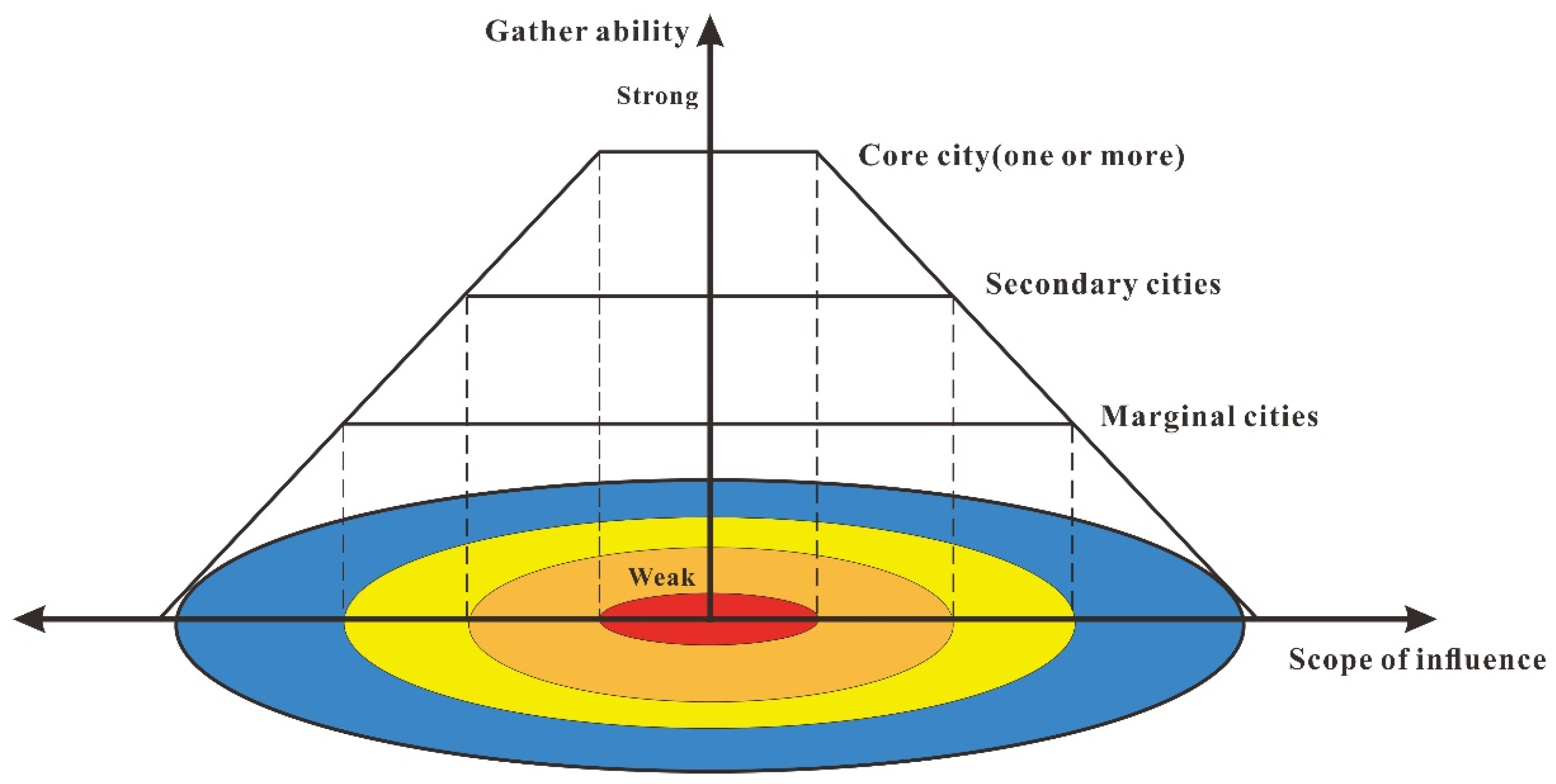
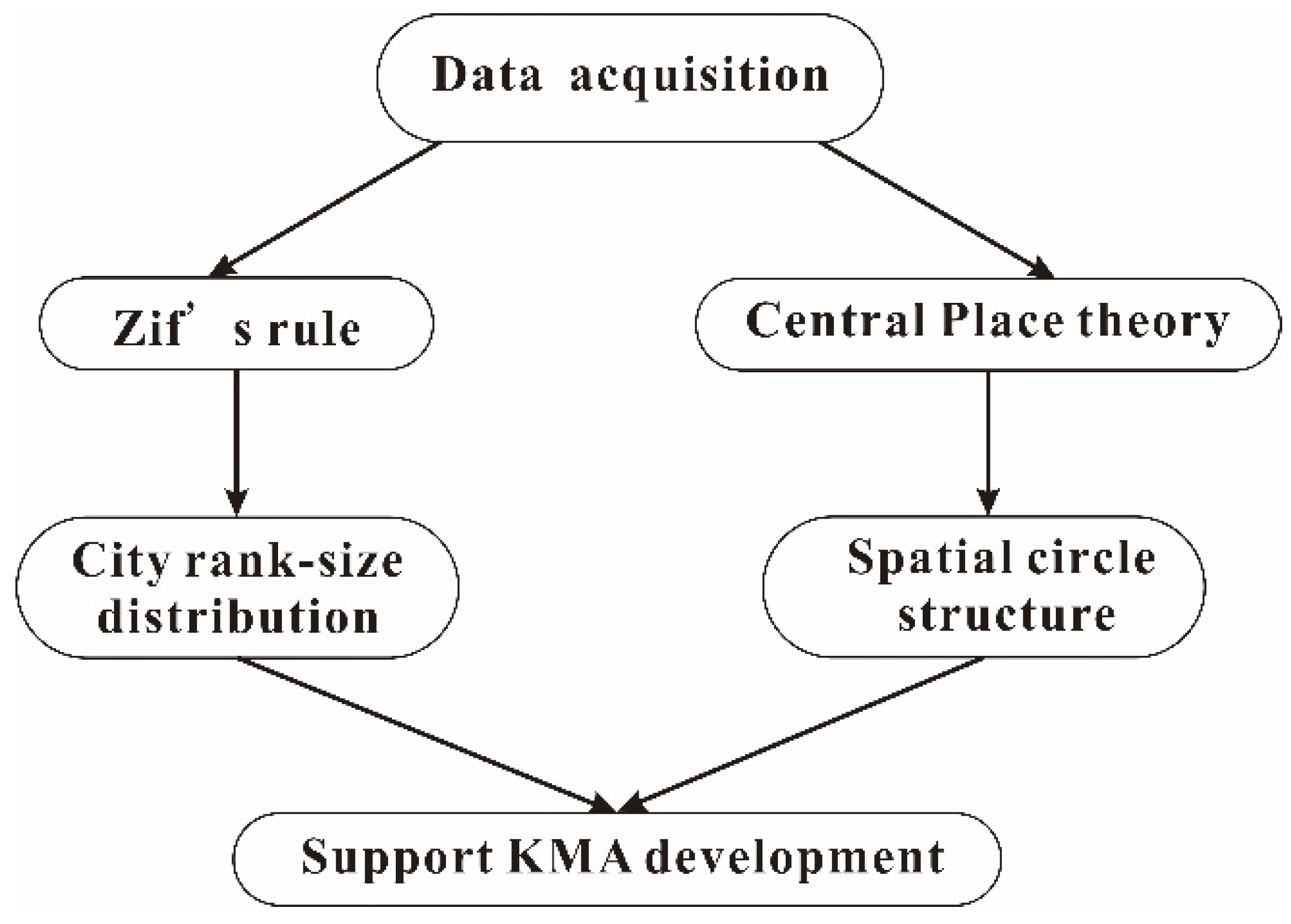
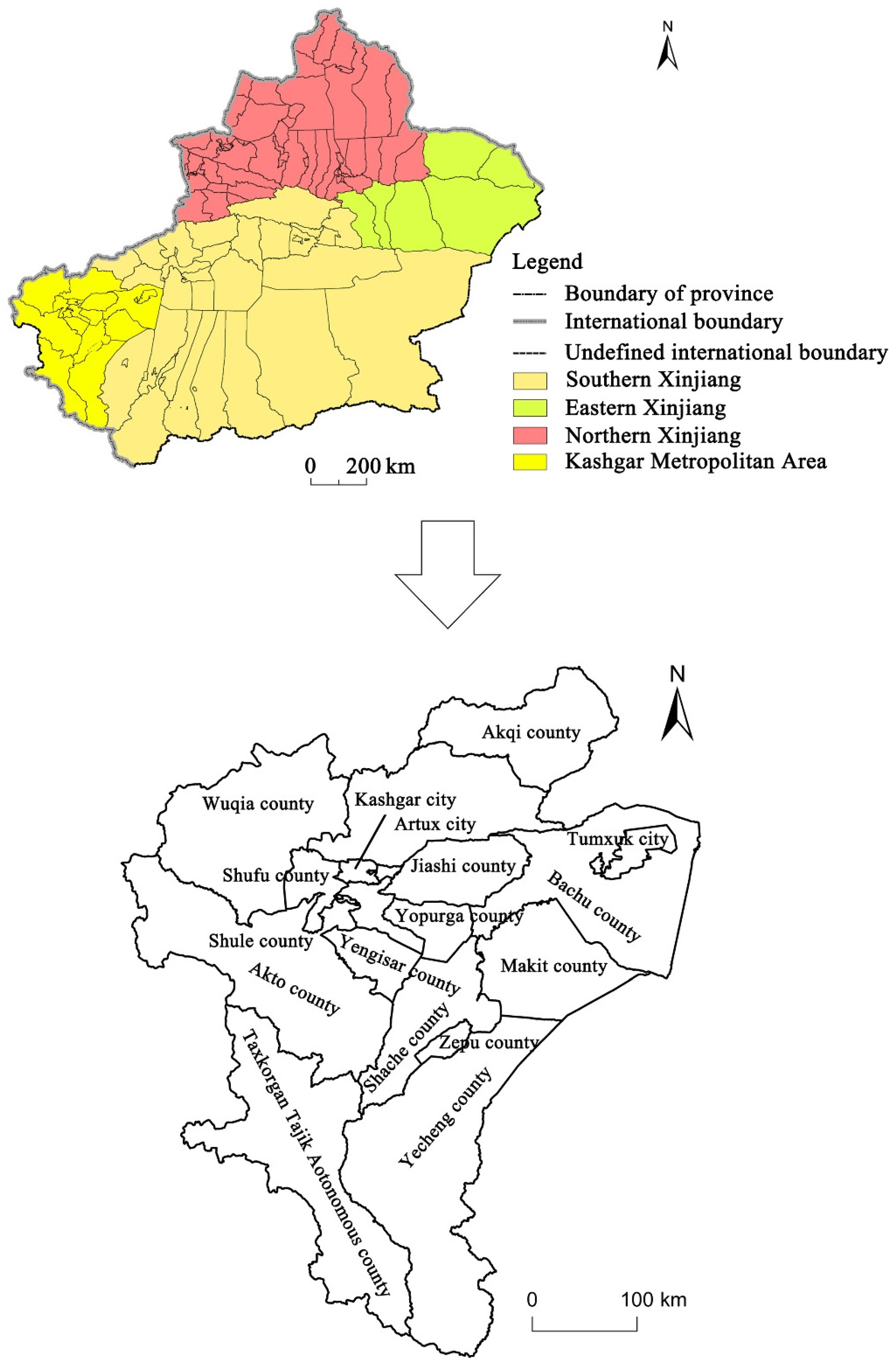
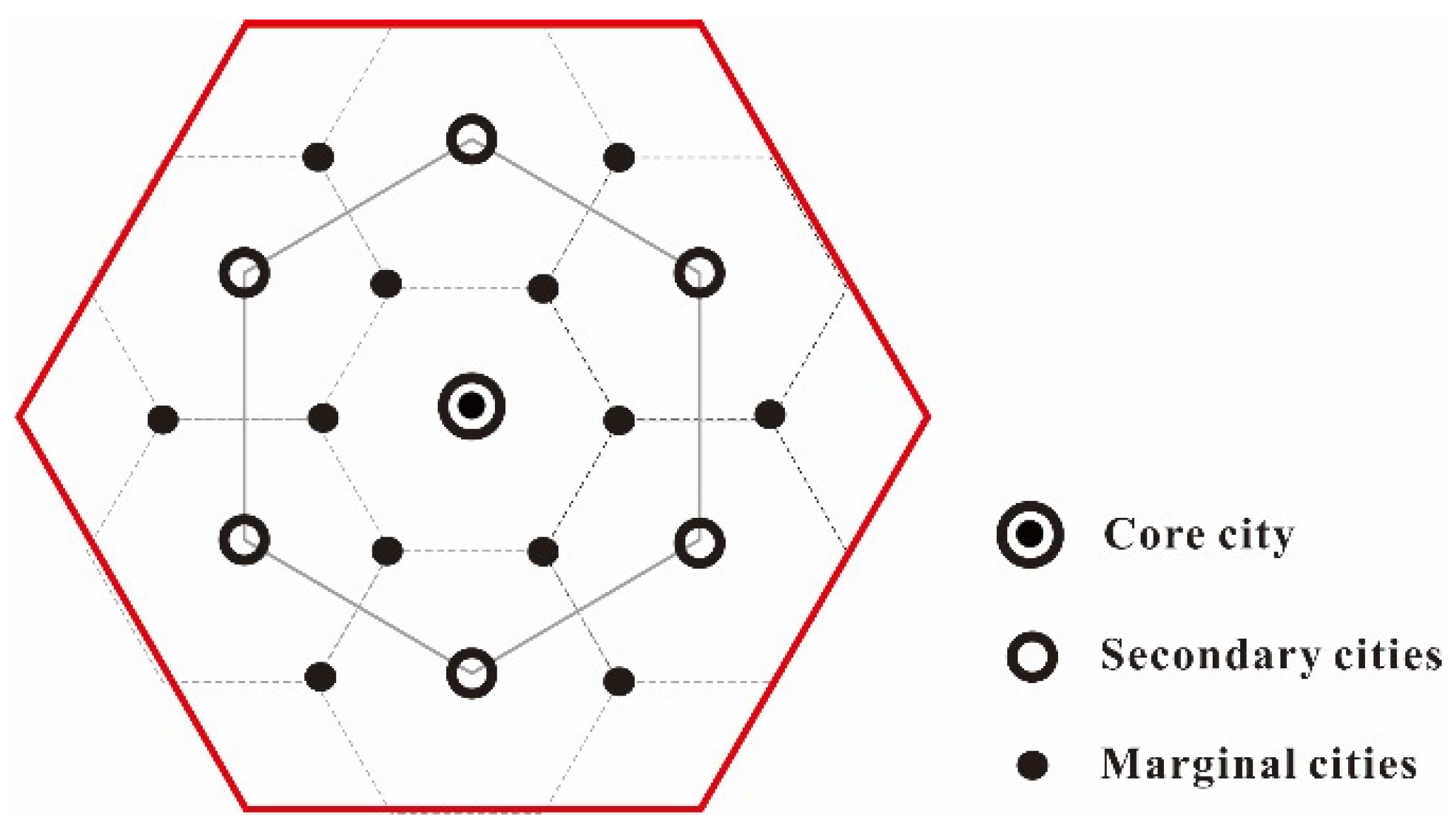
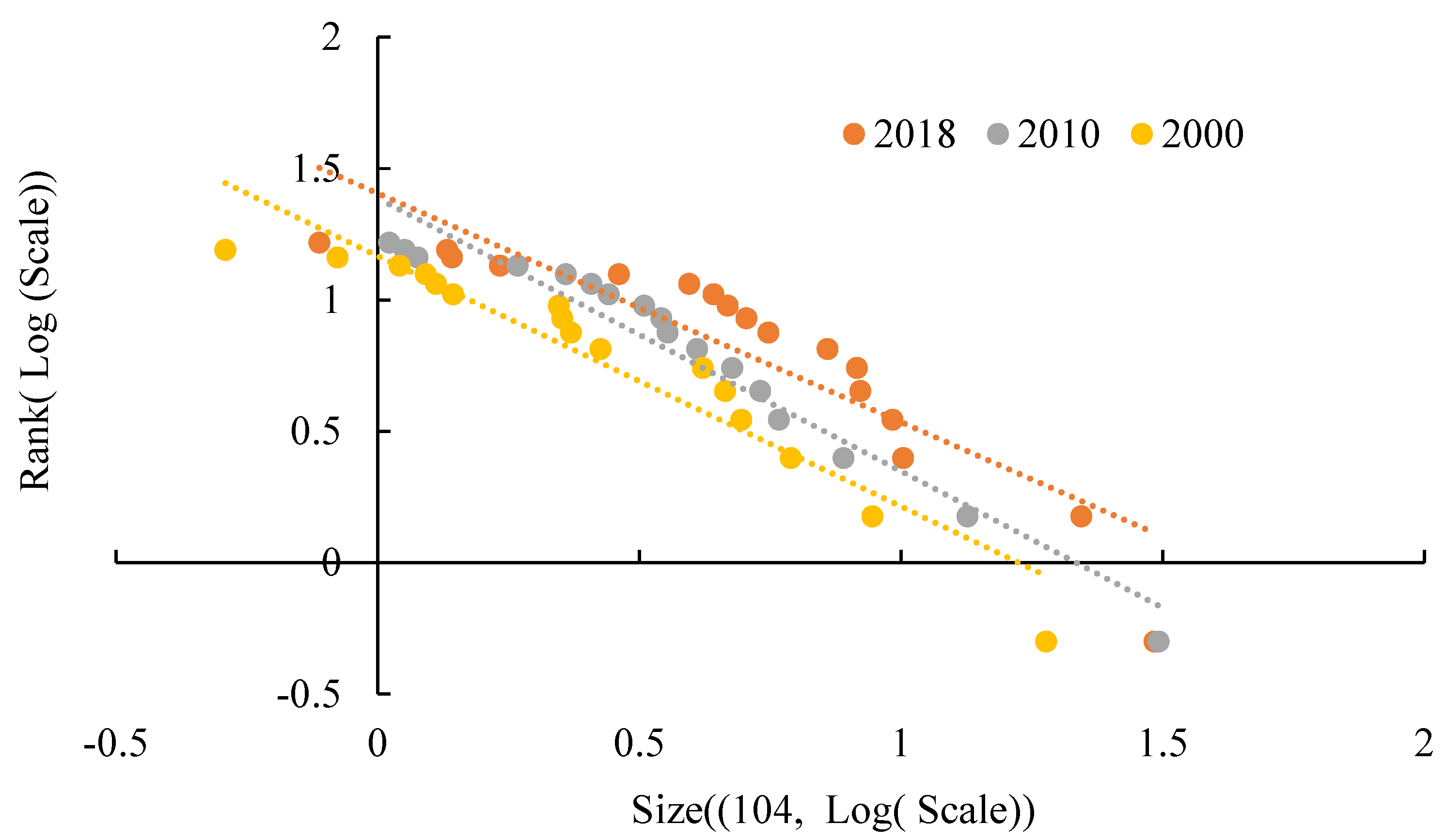
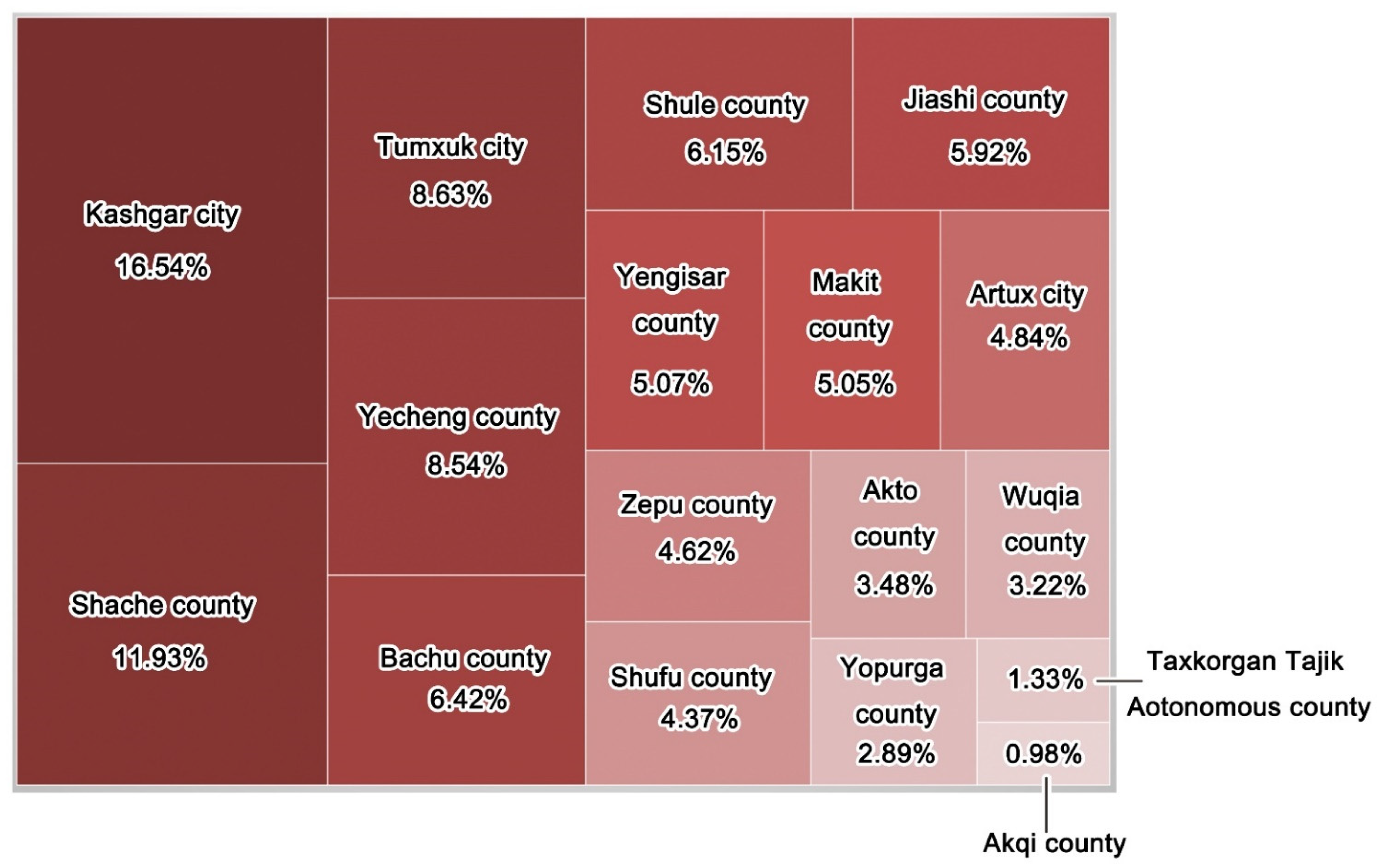

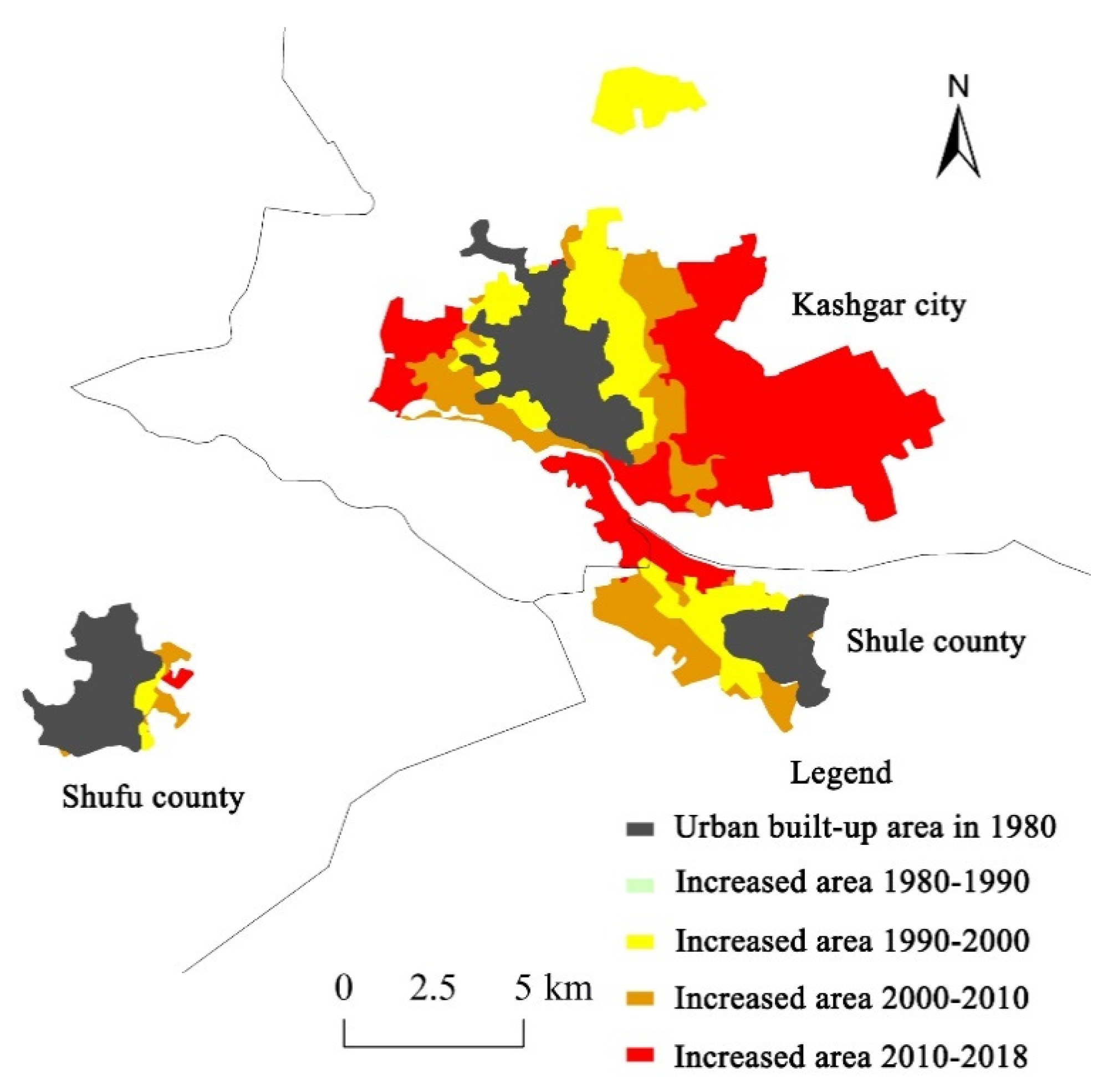

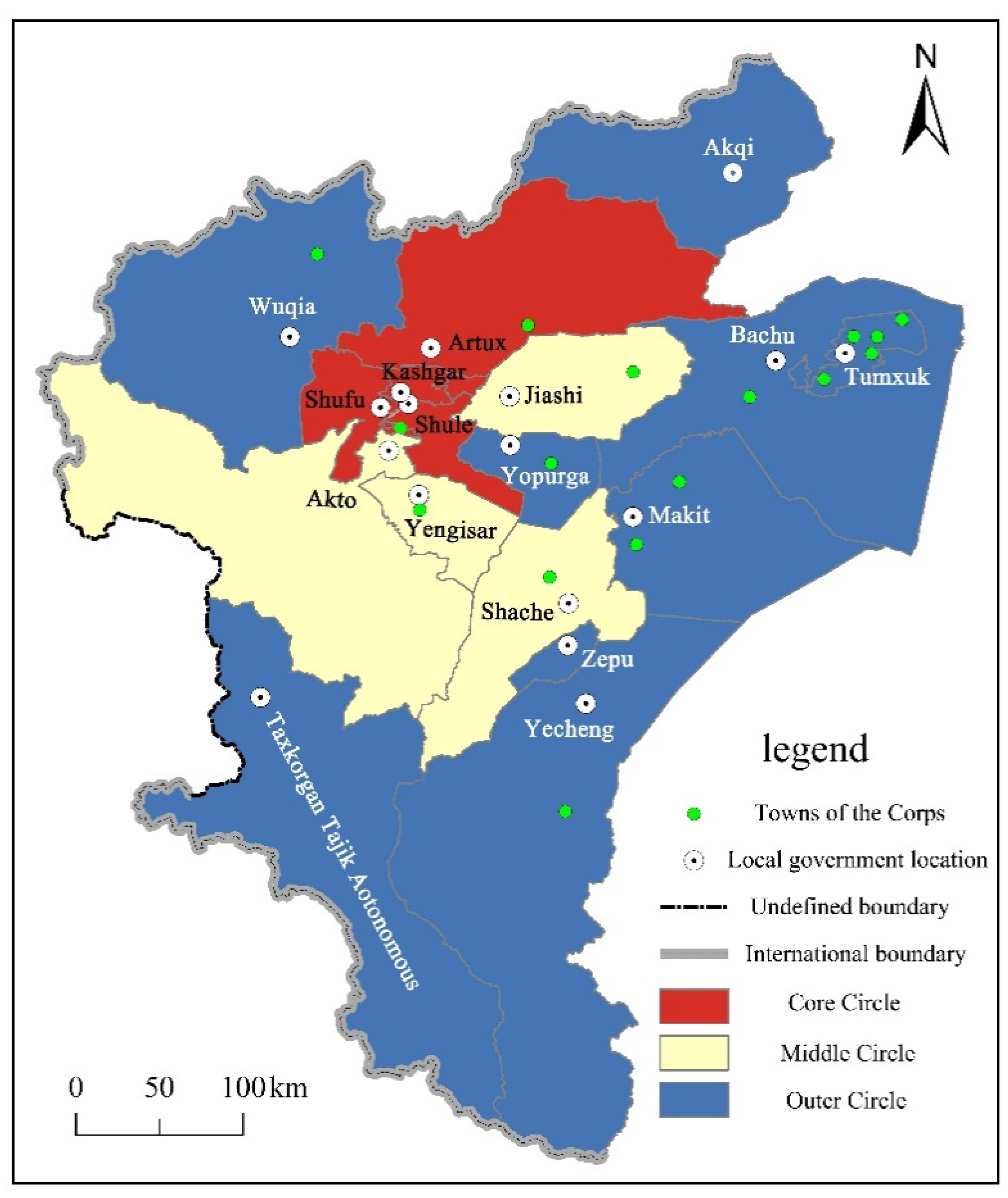

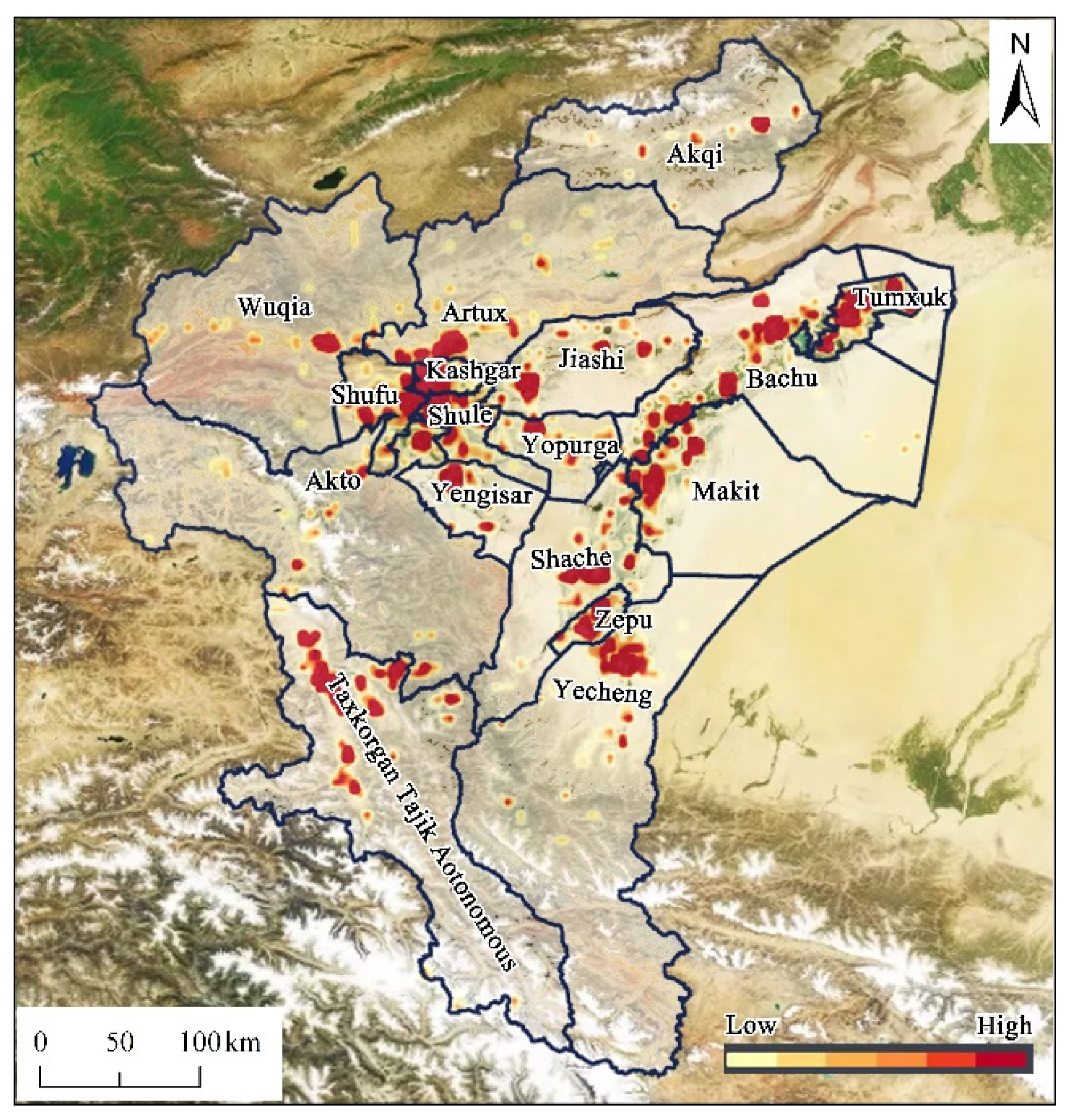
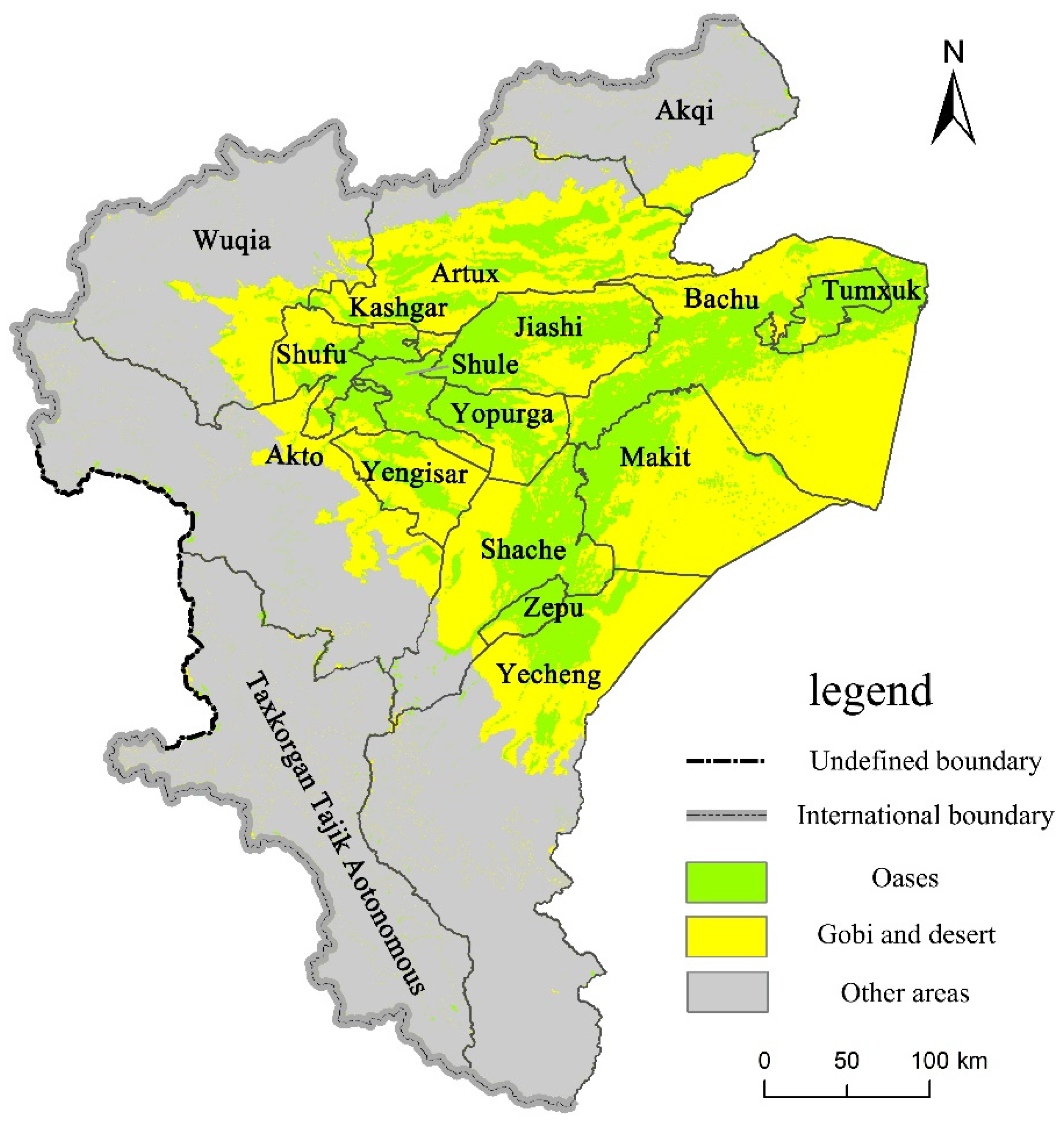
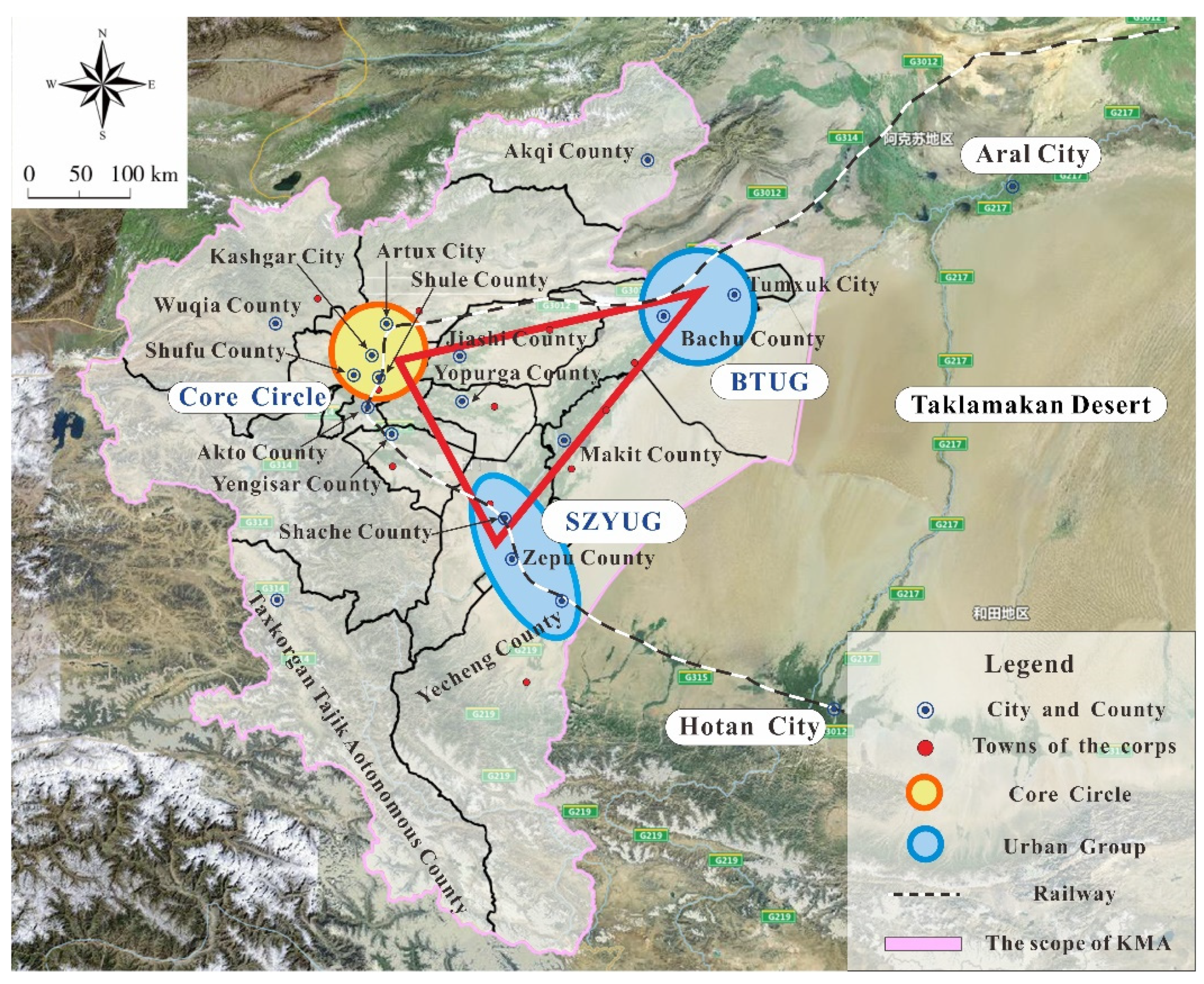
| Year | Remote Sensing Images | Spatial Resolutions/m |
|---|---|---|
| 1980 | MSS | 79 |
| 1990 | TM | 30 |
| 2000 | TM, CBERS | 30 and 19.5 |
| 2010 | TM, CBERS | 30 and 19.5 |
| 2018 | OLI | 30 |
| Traffic Travel Tools | Train | Car | Train and Car |
|---|---|---|---|
| 1 | 1.2 | 0.7 |
| Surrounding Cities/Core Cities | ≥70% | 45–70% | 20–45% | ≤20% |
|---|---|---|---|---|
| 0.8 | 1 | 1.2 | 1.5 |
| Year | The Regression Equation | R-Sq | R-Sq (Adjusted) | MSE | Pareto Exponent (α) |
|---|---|---|---|---|---|
| 2000 | log(Ri − 0.5) = −0.953*logPi + 1.167 | 91.1% | 90.5% | 0.0158 | 0.953 |
| 2010 | log(Ri − 0.5) = −1.04*logPi + 1.387 | 94.3% | 93.9% | 0.0102 | 1.04 |
| 2018 | log(Ri − 0.5) = −0.871*logPi + 1.406 | 82.31% | 81.13% | 0.0316 | 0.871 |
| Cities and Counties | E/km | S | Cities and Counties | E/km | S |
|---|---|---|---|---|---|
| Shule County | 14.40 | 9,471,473.17 | Wuqia County | 174.78 | 73,186.45 |
| Artux City | 37.13 | 3,127,107.55 | Makit County | 244.80 | 59,848.57 |
| Shufu County | 25.49 | 2,911,357.43 | Yopurga County | 172.44 | 45,029.24 |
| Akto County | 34.86 | 1,901,668.10 | Zepu County | 176.65 | 42,107.03 |
| Yengisar County | 57.12 | 581,897.12 | Tumxuk City | 398.40 | 14,891.36 |
| Shache County | 107.35 | 549,715.73 | Taxkorgan Tajik Aotonomous County | 521.10 | 6512.79 |
| Jiashi County | 94.90 | 307,590.92 | Akqi County | 1123.74 | 971.69 |
| Yecheng County | 171.01 | 220,788.03 | Wuqia County | 174.78 | 73,186.45 |
| Bachu County | 224.95 | 93,620.79 | Makit County | 244.80 | 59,848.57 |
| Cities and Counties | Vectors(E,S) | Spatial Circle Structure |
|---|---|---|
| Shule County | (1,1) | Core circle |
| Artux City | (1,1) | Core circle |
| Shufu County | (1,1) | Core circle |
| Akto County | (1,2) | Middle circle |
| Yengisar County | (2,2) | Middle circle |
| Shache County | (2,2) | Middle circle |
| Jiashi County | (2,2) | Middle circle |
| Yecheng County | (3,3) | Outer circle |
| Bachu County | (3,3) | Outer circle |
| Wuqia County | (3,3) | Outer circle |
| Makit County | (3,3) | Outer circle |
| Yopurga County | (3,3) | Outer circle |
| Zepu County | (3,3) | Outer circle |
| Tumxuk City | (3,3) | Outer circle |
| Taxkorgan Tajik Aotonomous County | (3,3) | Outer circle |
| Akqi County | (3,3) | Outer circle |
Publisher’s Note: MDPI stays neutral with regard to jurisdictional claims in published maps and institutional affiliations. |
© 2022 by the authors. Licensee MDPI, Basel, Switzerland. This article is an open access article distributed under the terms and conditions of the Creative Commons Attribution (CC BY) license (https://creativecommons.org/licenses/by/4.0/).
Share and Cite
Li, J.; Li, S.; Lei, J.; Zhang, X.; Qi, J.; Tohti, B.; Duan, Z. Analysis of Spatial Structure in the Kashgar Metropolitan Area, China. Land 2022, 11, 823. https://doi.org/10.3390/land11060823
Li J, Li S, Lei J, Zhang X, Qi J, Tohti B, Duan Z. Analysis of Spatial Structure in the Kashgar Metropolitan Area, China. Land. 2022; 11(6):823. https://doi.org/10.3390/land11060823
Chicago/Turabian StyleLi, Jiangang, Songhong Li, Jun Lei, Xiaolei Zhang, Jianwei Qi, Buayxam Tohti, and Zuliang Duan. 2022. "Analysis of Spatial Structure in the Kashgar Metropolitan Area, China" Land 11, no. 6: 823. https://doi.org/10.3390/land11060823
APA StyleLi, J., Li, S., Lei, J., Zhang, X., Qi, J., Tohti, B., & Duan, Z. (2022). Analysis of Spatial Structure in the Kashgar Metropolitan Area, China. Land, 11(6), 823. https://doi.org/10.3390/land11060823






